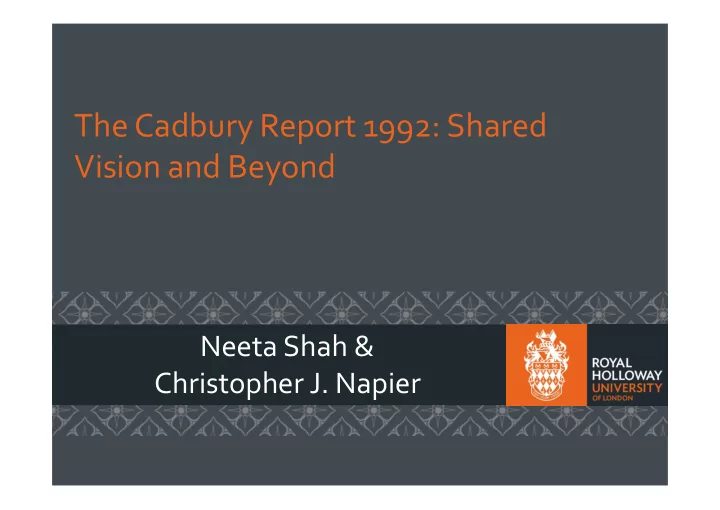

The Cadbury Report 1992: Shared Vision and Beyond Neeta Shah & Christopher J. Napier
Governance – not a new problem • The Cadbury Report is nearly 25 years old • As an expression, “ corporate governance ” seems to emerge in legal writings in 1930s • Important contribution of Bob Tricker ’ s book Corporate Governance (1984) • Problems of governance are recurring, particularly role of company directors
Victorian non-executive directors Earl of Marquess of Donoughmore Tweeddale
Good chaps and bad eggs Gerard Lee Lord Clarence Bevan Kylsant Hatry
How was Cadbury different? • Previous UK financial scandals usually led to legislative changes: • City of Glasgow Bank failure led to Banking Act of 1878 • London & General Bank frauds (Jabez Balfour) led to Companies Act 1900 • City Equitable Life Insurance fraud (Gerard Lee Bevan) led to Companies Act 1929 • Royal Mail Steam Packet Co. (Lord Kylsant) led (eventually) to Companies Act 1948 • Fire, Auto & Marine (Emil Savundra) led to Companies Act 1967
How was Cadbury different? • Cadbury Report offered a code of best practice • Based on belief that “ one size fits all ” solutions are not appropriate • Key concept of comply or explain • Report emerges against an interesting background: • “ Big Bang ” a relatively recent event – many traditional informal mechanisms overthrown • Financial Reporting Council recently established – looking to expand remit beyond accounting standards • Cadbury ’ s own background and personality
Defining corporate governance • Cadbury ’ s definition is “ the system by which companies are directed and controlled ” • Emphasis on role of directors, both individually and collectively as the board. • Assumption of unitary board model • As “ first mover ” , Cadbury ’ s definition was echoed by many subsequent governance codes, including the OECD Principles of Corporate Governance
Different notions of the “ company ” • The “ company ” is the shareholders collectively, with the board as their representatives controlling management (who are employees carrying on the company ’ s business): • This is usually associated with a philosophy of shareholder primacy • The “ company ” is the business itself, and the directors are the “ governors ” of the business: • This may be associated with a philosophy that other stakeholders are also important
Other definitions of governance • “ Giving overall direction to the enterprise, overseeing and controlling the executive actions of management and satisfying legitimate expectations of accountability and regulation by interests beyond the corporate boundary. ” [Robert Tricker, Corporate Governance , 1984] • “ The process of supervision and control intended to ensure that the company ’ s management acts in accordance with the interests of shareholders. ” [John Parkinson, Corporate Power & Responsibility , 1994 ]
Other definitions of governance • “ Ways to which suppliers of finance to corporations assure themselves of getting a return on their investment ” . [Shleifer & Vishny, “ A survey of corporate governance ” , Journal of Finance , 1997] • This definition emphasises the financial aspects of corporate governance, which is what Cadbury was commissioned to review back in 1991
A window into governance research • Search of key journals to identify articles that draw on Cadbury definition • Many papers do not provide a definition of corporate governance (though they may refer to Cadbury, OECD or a subsequent national governance code) • Research is diverse in terms of theoretical frameworks used • Much research is quantitative, but increasing use of qualitative methods: • Some studies are explicitly “ mixed-methods ”
A window into governance research • Geographical dispersion: • Many studies in “ Anglophone ” countries • Developed economies with active stock markets • Emerging/developing economies with smaller stock markets • Some comparative studies, often regional
A window into governance research • Common research topics: • Attitudes of stakeholders to governance • Disclosed governance practices and their “ determinants ” • Influence of governance practices on firm-specific variables, e.g.: • “ Firm performance ” • Financial structure • Analyst following/ratings by external agencies • Social and environmental practices
Challenges in governance research • Statistical significance prized over “ real ” significance • Effect size often not examined • Decline in variation of key governance “ variables ” over time • Governance variables may not change over period of investigation for specific companies • Is “ good performance ” the same as “ higher returns ” ? • How long does it take for governance changes to have an impact?
Codes as starting points, not ends • Many subsequent reports and reviews subsequent to Cadbury • UK Corporate Governance Code and OECD Principles never a final version, always subject to updating • Recurrent themes: • Shareholder focus – other stakeholders still largely overlooked • Financial focus • Still largely reliant on “ good chaps ” – role of board in setting the “ tone at the top ”
Future challenges • Does increasing use of “ Executive Committees ” in large companies make the Board of Directors even more distant from day-to-day operations? • Are modern corporations increasingly “ unaccountable ” and “ ungovernable ” ? • The information gap – how can directors “ direct and control ” what they don ’ t know about? • Can risk management systems address these concerns, or do they just lead to “ boilerplate ” ? • Is the introduction of “ Anglo-Saxon ” governance in emerging economies achieving anything more than “ ceremonial compliance ” ? • The “ bad eggs ” are still out there!
Recommend
More recommend